| Area |
Greenwood Creek |
| Topic |
Tour: Greenwood Creek near Hwy 1 February 2002 |
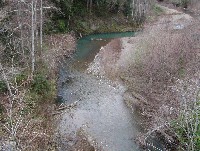 Click on image to enlarge (98K). Click here to display a larger version (285K).
Click on image to enlarge (98K). Click here to display a larger version (285K).This photo shows Greenwood Creek looking downstream off the Highway 101. Note that the channel has some positive indicators of fish habitat quality with woody debris, cobble and gravel, and a closely encroaching riparian. Photo provided by Pat Higgins, February 15, 2002.
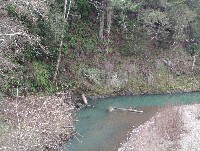 Click on image to enlarge (111K). Click here to display a larger version (327K).
Click on image to enlarge (111K). Click here to display a larger version (327K).Close up of lateral scour bedrock pool in Greenwood Creek just downstream of Highway 1 and not far upstream of the ocean. Large wood combines with boulders to provide very good cover for salmonids. Photo provided by Pat Higgins, February 15, 2002.
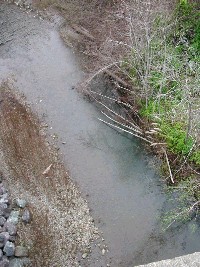 Click on image to enlarge (93K). Click here to display a larger version (439K).
Click on image to enlarge (93K). Click here to display a larger version (439K).Looking straight down from the Highway 1 Bridge on the downstream side at Greenwood Creek below. Rip rap at bottom left in the photo has been placed to protect the foundation of the bridge. The narrowing of the channel here may have increased fluvial energy and could account for sorting of larger bed particle size. The young willows colonizing the gravel bar at left suggest low flow years in 2000-2001. The green at right appears to be the highly invasive English ivy. Photo provided by Pat Higgins, February 15, 2002.
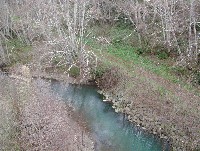 Click on image to enlarge (103K). Click here to display a larger version (307K).
Click on image to enlarge (103K). Click here to display a larger version (307K).This photo shows Greenwood Creek upstream of the Highway 1 Bridge and a hole formed by rip rap. This material was placed to armor the stream bank and prevent damage to the foundation for the bridge. Alder is recruiting in the interstitial spaces of the rock structure, which will provide better cover for fish, some shade and prevent the structure from unraveling during high flows. Photo provided by Pat Higgins, February 15, 2002.
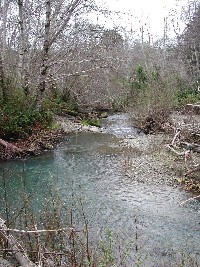 Click on image to enlarge (119K). Click here to display a larger version (605K).
Click on image to enlarge (119K). Click here to display a larger version (605K).Greenwood Creek has diverse fish habitat in this photo which would be good for both rearing juvenile and returning adult steelhead. A complex pool at left spills into a riffle with good cover. The top of another pool is visible at a distance in the picture. The Highway 1 Bridge is at upper right. Photo provided by Pat Higgins, February 15, 2002.
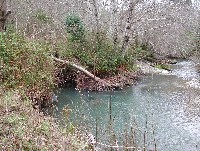 Click on image to enlarge (129K). Click here to display a larger version (392K).
Click on image to enlarge (129K). Click here to display a larger version (392K).Close up of pool on Greenwood Creek which is formed by a small debris jam, alder roots and bank. The jam provides both overhead and submerged cover for steelhead juveniles and possibly holding habitat for an adult steelhead on the day this picture was taken. Gravel size in the tailout of the pool indicates that this could also serve as spawning habitat, although peak use might be later in the season. Photo provided by Pat Higgins, February 15, 2002.
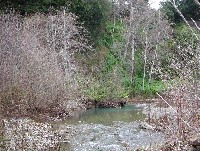 Click on image to enlarge (126K). Click here to display a larger version (380K).
Click on image to enlarge (126K). Click here to display a larger version (380K).This photo was taken just upstream of the pool in Pictures #5-6. Gravels look suitable for spawning. Willow and alder in the margins will provide greatly increased cover during summer when they leaf out. There are conifers and bay trees in the overstory of the canopy here. The green low growing plant on the far shore is English ivy, which can have some detrimental effects on riparian forest communities. Photo provided by Pat Higgins, February 15, 2002.
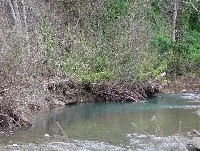 Click on image to enlarge (116K). Click here to display a larger version (347K).
Click on image to enlarge (116K). Click here to display a larger version (347K).Close up of a lateral scour log formed pool on Greenwood Creek. The terrace at left is likely the January 1997 level of gravel movement at this location. The stream power here has allowed down cutting and channel recovery. Most of the wood in the photo is either hardwood or very old coniferous trees. Hardwoods only last about five years as habitat forming elements in the stream before rotting out. Note that the English ivy is growing up the alder and willow trees. Photo provided by Pat Higgins, February 15, 2002.
To learn more about this topic click Info Links
To view additional information (data source, aquisition date etc.) about this page, click Metadata
 Click on image to enlarge (98K). Click here to display a larger version (285K).
Click on image to enlarge (98K). Click here to display a larger version (285K). Click on image to enlarge (111K). Click here to display a larger version (327K).
Click on image to enlarge (111K). Click here to display a larger version (327K). Click on image to enlarge (93K). Click here to display a larger version (439K).
Click on image to enlarge (93K). Click here to display a larger version (439K). Click on image to enlarge (103K). Click here to display a larger version (307K).
Click on image to enlarge (103K). Click here to display a larger version (307K). Click on image to enlarge (119K). Click here to display a larger version (605K).
Click on image to enlarge (119K). Click here to display a larger version (605K). Click on image to enlarge (129K). Click here to display a larger version (392K).
Click on image to enlarge (129K). Click here to display a larger version (392K). Click on image to enlarge (126K). Click here to display a larger version (380K).
Click on image to enlarge (126K). Click here to display a larger version (380K). Click on image to enlarge (116K). Click here to display a larger version (347K).
Click on image to enlarge (116K). Click here to display a larger version (347K).